Andy Reid, window dressing, the leak concept, and touchdowns
How the leak concept demonstrates the difficulties in defending the Chiefs' head coach's offense
Surprise and misdirection are two of the most fundamental aspects of offensive design and play calling at the NFL level. Every single play, 11 of the best football players on the planet (even when playing the Raiders, this remains true), who have spent hours and hours studying your every tendency, are determined to stop you from moving the ball even a single yard forward. Everyone is fast, everyone is strong, and everyone has instincts honed from years practice.
Every coach knows that showing an opponent something they aren’t prepared for or getting them to move the wrong direction can make life easier for an offense. However, some coaches are drastically better at doing so than others.
Andy Reid has been known as one of the best offensive minds in the league since he first got started as a head coach in 1999. And while other coaches are able to make noise for a few years before the league catches up to their novel ideas, Reid continues to churn out good offenses more than 2 decades since his start as a primary play caller.
How does he do it? The common narrative is that Reid morphs his offensive design around the skillset of his players (rather than forcing his players to fit into “his” system), and there’s some truth to that. However, Reid’s offense carries many of the same principles it has since he was calling plays for the Eagles at the start of the millennium. What separates Reid is his ability to disguise what he’s doing before the snap and even after the snap. The common term that gets thrown around is “window dressing,” and it’s high time we appreciate just how much better Reid is at this than almost anyone else. We’ll do it by using one of the Chiefs’ most successful concepts in 2019: the leak concept.
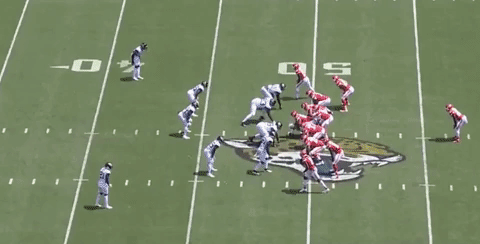
This touchdown from Mahomes to Watkins came in Week 1 against a hilariously outmatched Jaguars defense. The Chiefs marched the ball up and down the field with impunity prior to Mahomes’ ankle getting nicked up, and this touchdown was no exception. It’s also an excellent example of a leak concept.
Leak carries a very simple idea: have a receiver run across the field on what looks like a shallow crosser or drag route, but then turn up as they approach the sideline on the opposite side of the field. I’ve seen it referred to as a “drag and go” route, which is pleasing given it sounds like “dragon go.”
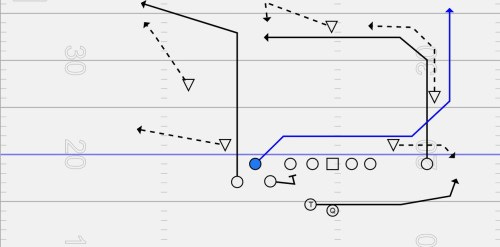
This is just one example of what a leak concept looks like in LSU’s offense (hat tip to Cover 1’s excellent article on LSU’s passing attack). As evidenced by Watkins’ touchdown against Jacksonville, this concept is deadly against zone defenses because it attacks an area designed to be vacated. A faster-developing route draws away the deep safety towards the middle of the field and Watkins ends up all by himself. It’s an excellent concept provided it takes the opponent by surprise and the pass protection holds up.
And this is where we start to have fun. The Chiefs scored touchdowns using this same concept multiple times in 2019, and every time Reid gave them a great chance at success. They scored against Denver weeks later on a deep touchdown to Tyreek Hill.

It should be noted that this is an entirely different coverage look than what the Jaguars used in Week 1. Hill, the receiver being targeted, is facing man coverage from an excellent cornerback in Chris Harris. The beauty of leak is that it allows a fast receiver to run away from coverage across the field, and can take advantage of a cornerback being lulled to sleep thinking they have the route figured out as a drag/crosser.
Here’s where it gets most interesting, at least for me. Look at how the Chiefs are lined up before the snap

Now compare that to how they lined up on the Watkins touchdown.
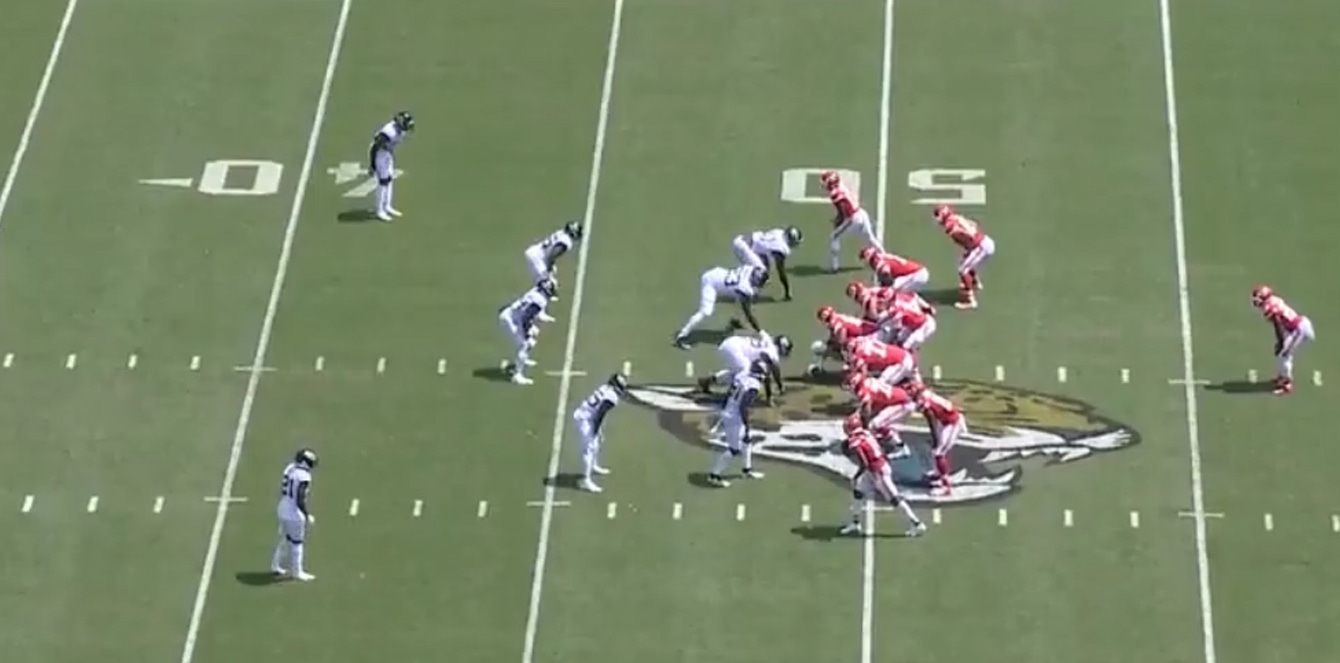
In Week 1, the Chiefs lined up with 3 wide receivers and 1 tight end. They were even with 2 players on each side of the line, and had Kelce and Watkins (the eventual target) line up as H-backs with the remaining receivers staying close to the line. Later in the season against Denver, they utilized different personnel (2 receivers, 2 tight ends) and a different formation, with 3 potential receivers on the right of the line and Hill lined up farther outside on the left.
(Hey, if you’re enjoying this and haven’t subscribed yet, just know there are several dozen articles breaking down Chiefs film and other things from the last 2 months that you’re missing out on, and we’re just getting started as football approaches. You can subscribe for the price of a fast food lunch by clicking the button below. Do it. DO IT.)
Once the ball is snapped, the similarity of the concepts starts to come into focus, with a play action, sliding protection, and a blocker making his way across the line to slow down the free rusher. Additionally, both plays call for 2 receivers to try and drag the defense left.
Based on the way the plays are lined up, though, it’s impossible for a defender to anticipate that the Chiefs are going to utilize the same concept they did in Week 1. This is particularly true since the Broncos know they’re using a different style of defense.
Fast forward to the very next week.
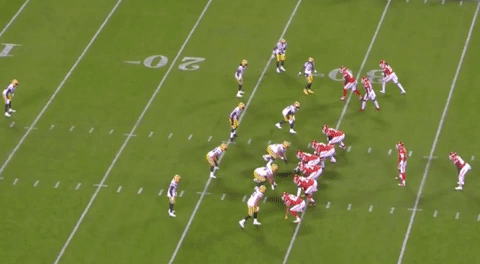
Reid has now modified not just the pre-snap look, but the way the concept is executed. Once again, the Chiefs are lined up differently to prevent any anticipation by Green Bay.
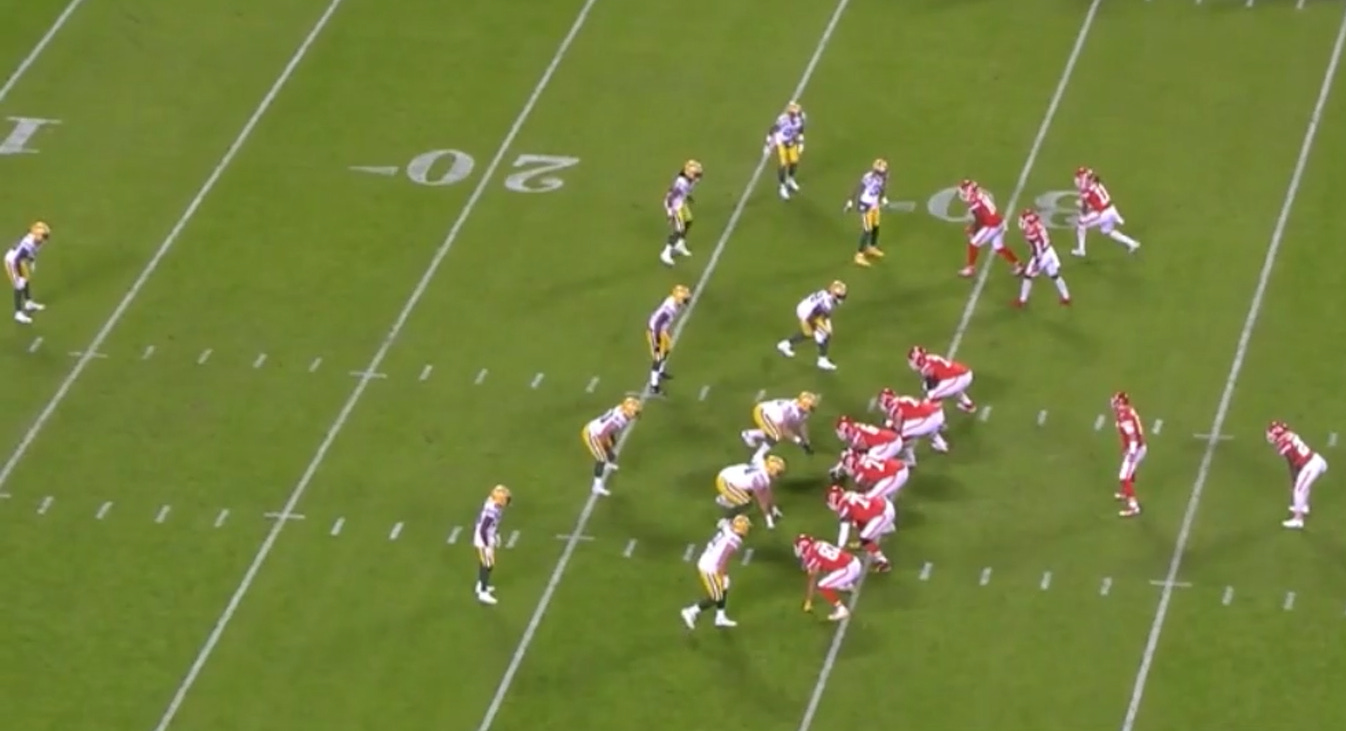
The Chiefs utilize trips like they did against Denver, but it’s now 3 receivers (instead of 2 receivers and a tight end) and they are lined up farther from the offensive line. Kelce is lined up as an inline tight end, and rather than immediately releasing like Watkins and Hill did he takes on the free rusher for a moment (again, the point is to slow the rusher down so the play has time to develop) before moving into space. Further, Reid has Matt Moore line up in the pistol rather than under center.
The things Reid does to “dress up” the play this time are incredibly intricate, but they’re all still aimed at the same purpose of dragging the defense away from the deep right area of the field. As the ball is snapped, Reid sends 2 receivers in motion left in succession to threaten a pair of shovel passes. It’s a unique look that creates the appearance of trying to get Hill in space with a blocker in front of him. In the meantime, Moore moves to his right (away from the free rusher), which is the direction Damien Williams is moving for a threatened pitch or quick sideline throw.

You may have heard that Reid stretches defenses horizontally as well as vertically, and that’s exactly what this is. All the movement up front sucks the defense forward and towards the sidelines, all while Kelce stays engaged with his blocker. By the time Kelce starts to release, the safety is making a choice to cover a deep post and is about to run himself out of the play.
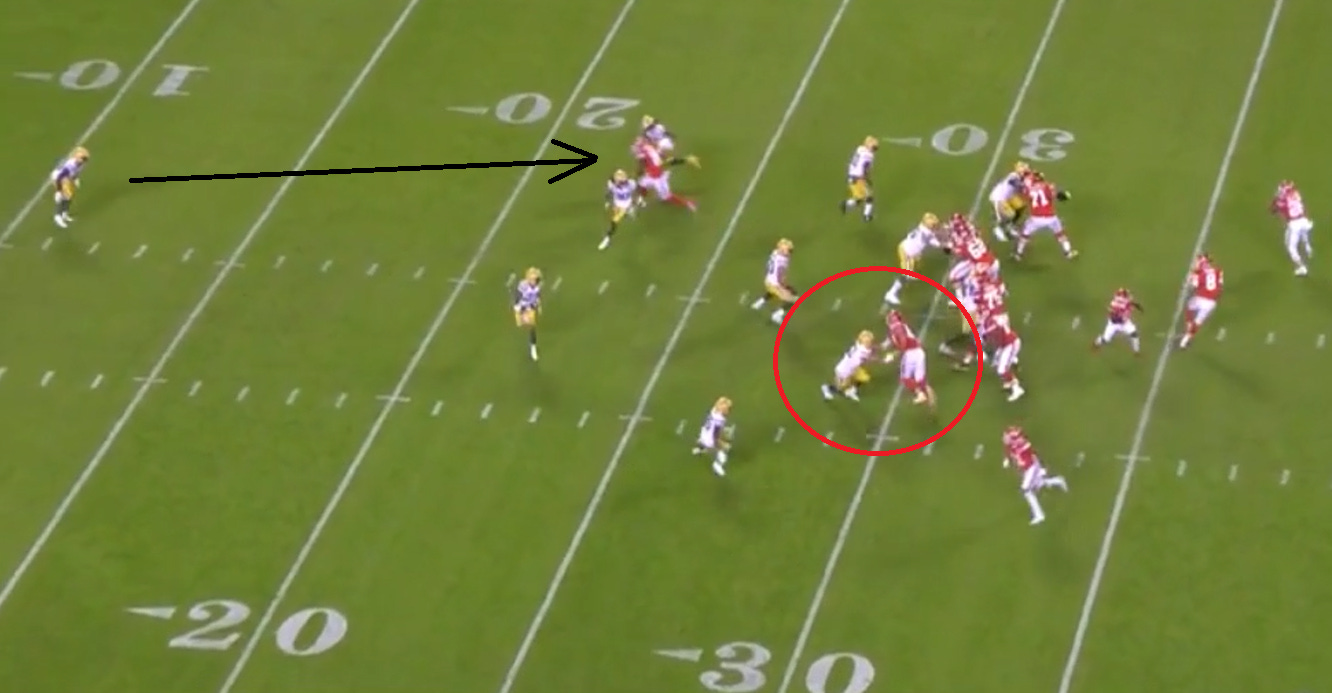
It’s impossible to blame the safety here. He knows that the other defenders on that side of the field have to account for the receivers in motion, so that leaves the cornerback alone on a deep route that can create a favorable “chuck it up” situation for the quarterback. Additionally, he has absolutely no way of realizing what Kelce is about to do, as he’s still at the line of scrimmage.
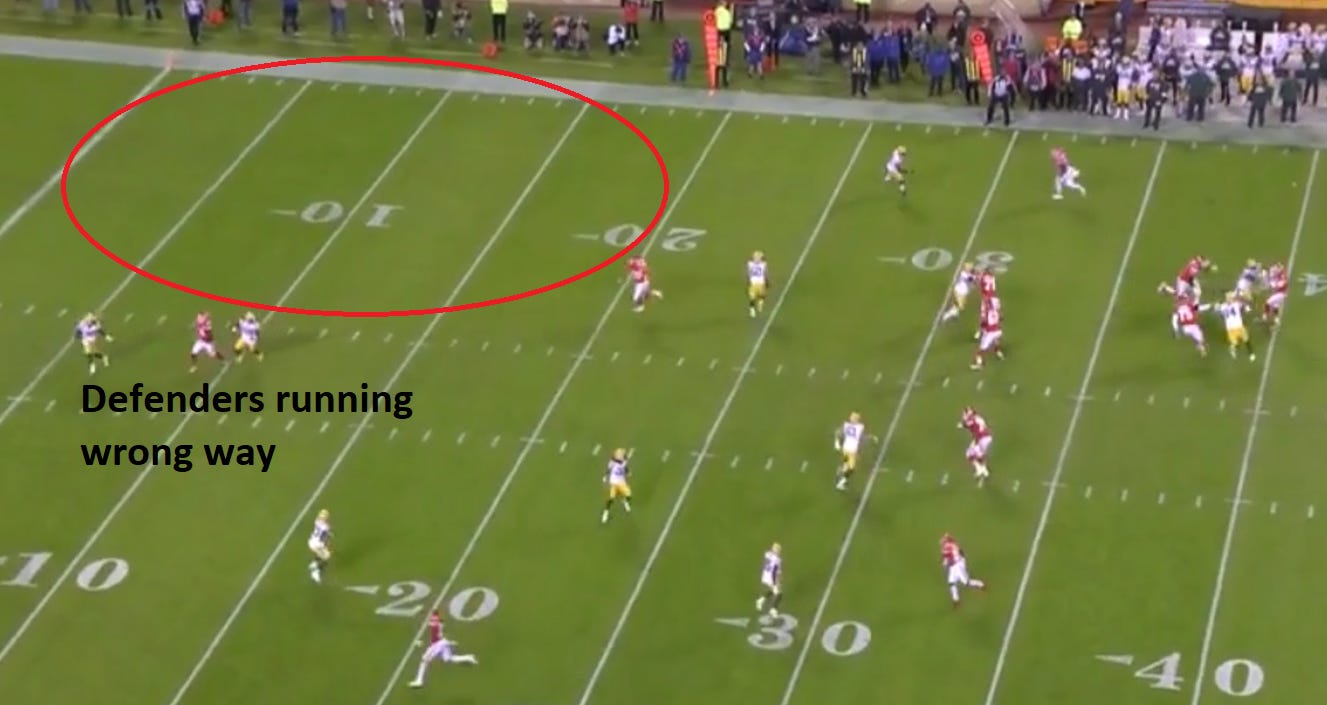
As Moore releases (and to his credit, he waits until the last possible second to throw the ball so the play can develop), there is no one even close to being in position to stop this play. Both deep defenders are running the wrong direction and don’t realize the ball is being thrown. The shallow defenders are still watching Williams or the receivers who went into motion. Kelce has time to turn around and locate the ball, then walk into the end zone.
Three plays, three leak concepts to the same area, three completely different looks. This is what makes Andy Reid great. And when the Chiefs needed yardage on the biggest stage, he dialed leak up again to the other side of the field with still more window dressing.

Same concept, dressed up differently and disguised using motion multiple times. This time the eventual receiver (Watkins) motions to his spot as an H-back across the line after Kelce motions over to create the appearance of trips. Watch the 49ers defense desperately try to communicate pre-snap, only to still be beaten.
Reid is not inventing new concepts all the time. Rather, he finds ways to take things that work and make them look different before and after the snap so opposing defenses can’t predict what is coming. There might be no one better in the league at doing this, and it’s one of the reasons he’s going to the Hall of Fame someday.
This upcoming season, watch for similar concepts and how Reid dresses them up before the snap. You’ll start to recognize the same things working over and over, and defenses unable to see them coming. And that will make you smile. Andy’s good like that.
(Hey, if you liked this, do me a favor and share it. Hopefully it can bring a smile to someone else’s face. I’ve also got to show Mrs. MNchiefsfan that starting this newsletter was a good idea, so the more people who see it, the more likely I can tell her “I told you so!”)




That first quarter against Jacksonville was hilarious. Mahomes in 2 years basically ruined that defense that was so good. Imagine this offense with no injuries...
Great , just great stuff ! Thanks Seth !